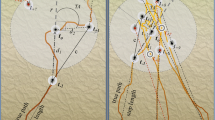Abstract
The Indo-Pacific, intertidal chiton Acanthopleura gemmata (Blainville) is a central place forager which occupies definite, actively dug and defended scars, and migrates during nocturnal low tides up to 3 m away to feed on algal grounds. After each feeding excursion, most chitons home precisely to their scars. Photographic tracking, using lightemitting diodes (LED) glued to the chitons, and experiments were conducted throughout 45 d (August to September 1984) along the Nimu Peninsula (Somalia) in order to elucidate the importance of trail following in the homing and feeding of this species. LED tracking of the chitons throughout each activity phase and trail interruption experiments showed that following the personal outgoing trail is a basic homing mechanism in this species. Translocation of the chitons on a conspecific trail and homing performance analysis revealed that the trail-associated information involved in the homing is polymorphic in the population, thus minimizing the probability of following a conspecific trail despite the frequent trail crossings due to high population density. The LED tracking throughout successive activity phases showed a high coincidence between the paths traced by the same chiton night after night. In the few cases when the outgoing and return paths of the first night markedly diverge, the home-feeding ground route of the successive night overlaps the return trail of the previous night. A less pronounced inter-individual trail following also occurs during foodward excursions. These findings suggest that the trails released by A. gemmata are complex, including both quasi-individual and species-specific information. Moreover, this chiton may utilize its trail following capacity not only to home, but also for the retrieval of the feeding grounds night after night.
Similar content being viewed by others
Literature cited
Batschelet, E. B.: Circular statistics in biology, 371 pp. London: Academic Press 1981
Bohn, G.: De lorientation chez les patelles. C. R. Acad. Sci. 148, 868–870 (1909)
Branch, G. M.: The biology of limpets: physical factors, energy flow and ecological interactions. Oceanogr. Mar. Biol. A. Rev. 19, 235–380 (1981)
Chelazzi, G., P. Della Santina and M. Vannini: Long-lasting substrate marking in the collective homing of the gastropod Nerita textilis. Biol. Bull. mar. biol. Lab., Woods Hole 168, 214–221 (1985)
Chelazzi, G., S. Focardi and J. L. Deneubourg: A comparative study on the movement patterns of two sympatric tropical chitons (Mollusca: Polyplacophora). Mar. Biol. 74, 115–125 (1983a)
Chelazzi, G., S. Focardi, J. L. Deneubourg and R. Innocenti: Competition for the home and aggressive behaviour in the chiton Acanthopleura gemmata (Mollusca: Polyplacophora). Behav. Ecol. Sociobiol. 14, 15–20 (1983b)
Chelazzi, G., R. Innocenti and P. Della Santina: Zonal migration and trail-following of an intertidal gastropod analyzed by LED tracking in the field. Mar. Behav. Physiol. 10, 121–136 (1983c)
Chelazzi, G. and D. Parpagnoli: Behavioural responses to crowding modification and home intrusion in Acanthopleura gemmata (Mollusca: Polyplacophora). Ethology (In press)
Cook, A.: Functional aspects of trail following by the carnivorous snail Euglandina rosea. Malacologia 26, 173–181 (1985)
Cook, A., O. S. Bamford, J. D. B. Freeman and D. J. Teideman: A study of the homing habit of the limpet. Anim. Behav. 17, 330–339 (1969)
Cook, S. B.: Experiments on homing in the limpet Siphonaria normalis. Anim. Behav. 17, 679–682 (1969)
Cook, S. B.: A study of the homing behaviour in the limpet Siphonaria alternata. Biol. Bull. mar. biol. Lab., Woods Hole 141, 449–457 (1971)
Cook, S. B.: The role of the home scar in pulmonate limpets. Bull. Am. Mal. Union 1976, 34–37 (1976)
Cook, S. B. and C. B. Cook: Directionality in the trail-following response of the pulmonate limpet Siphonaria alternata. Mar. Behav. Physiol. 3, 147–155 (1975)
Creese, R.: Patterns of growth, longevity and recruitment of intertidal limpets in New South Wales. J. exp. mar. Biol. Ecol. 51, 145–171 (1981)
Deneubourg, J. L., J. M. Pasteels and J. C. Verhaeghe: Probabilistic behaviour in ants: a strategy of errors. J. theor. Biol. 105, 259–271 (1983)
Funke, W.: Heimfindevermögen und Orstreue bei Patella L. (Gastropoda, Prosobranchia). Oecologia 2, 19–142 (1968)
Galbraith, R. T.: Homing behaviour in the limpets Acmaea digitalis and Lottia gigantea. Am. Midl. Nat. 74, 245–246 (1965)
Hamilton, P. V.: The use of mucous trails in gastropod orientation studies. Malac. Rev. 10, 73–76 (1977)
Hirano, Y. and A. Inaba: Siphonaria (Pulmonate limpet) survey of Japan. l. Observations on the behaviour of Siphonaria japonica during breeding season. Publ. Seto mar. biol. Lab. 25, 323–334 (1980)
Jessee, W. F.: Studies of homing behaviour in the limpet Acmaea scabra. Veliger 11, 52–55 (1968)
Lowe, E. F. and R. L. Turner: Aggregation and trail-following in juvenile Bursatella leachii pleii. Veliger 19, 153–155 (1976)
McFarlane, I. D.: In the intertidal homing gastropod Onchidium verruculatum (Cuv.) the outward and homeward trails have a different information content. J. exp. mar. Biol. Ecol. 51, 207–218 (1981)
Ohgushi, R.: Ethological studies on the intertidal limpets. II. Analytical studies on the homing behavior of two species of limpets. Jap. J. Ecol. 5, 31–35 (1955)
Pieron, H.: Contribution à la biologie de la patelle et de la calyptrée. Le sens de retour et la mémoire topographique. Arch. Zool. exp. gen. V sér 1, 18–29 (1909)
Schöne, H.: Spatial orientation, 374 pp. Princeton: Princeton University Press 1984
Snyder, N. F. R. and H. A. Snyder: Pheromone mediated behaviour of Fasciolaria tulipa. Anim. Behav. 19, 257–268 (1971)
Stirling, D. and P. V. Hamilton: Observations on the mechanism of detecting mucous trail polarity in the snail Littorina irrorata. Veliger 29, 31–37 (1986)
Thorne, M. J.: Homing in the chiton Acanthozostera gemmata (Blainville). Proc. R. Soc. Qd 79, 99–108 (1968)
Thorpe, W. H.: Learning and instinct in animals, 558 pp. London: Methuen 1963
Author information
Authors and Affiliations
Additional information
Communicated by B. Battaglia, Padova
Rights and permissions
About this article
Cite this article
Chelazzi, G., Della Santina, P. & Parpagnoli, D. Trail following in the chiton Acanthopleura gemmata: operational and ecological problems. Mar. Biol. 95, 539–545 (1987). https://doi.org/10.1007/BF00393097
Accepted:
Issue Date:
DOI: https://doi.org/10.1007/BF00393097




